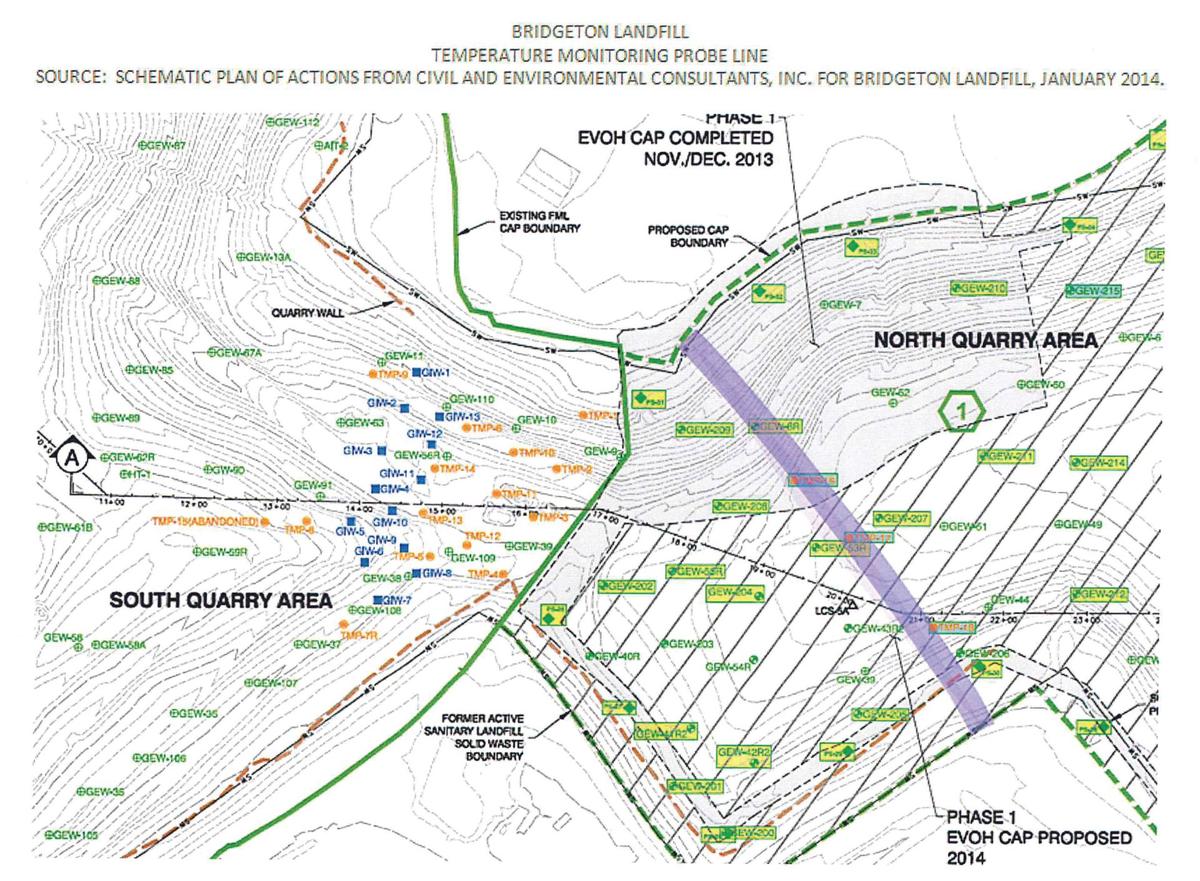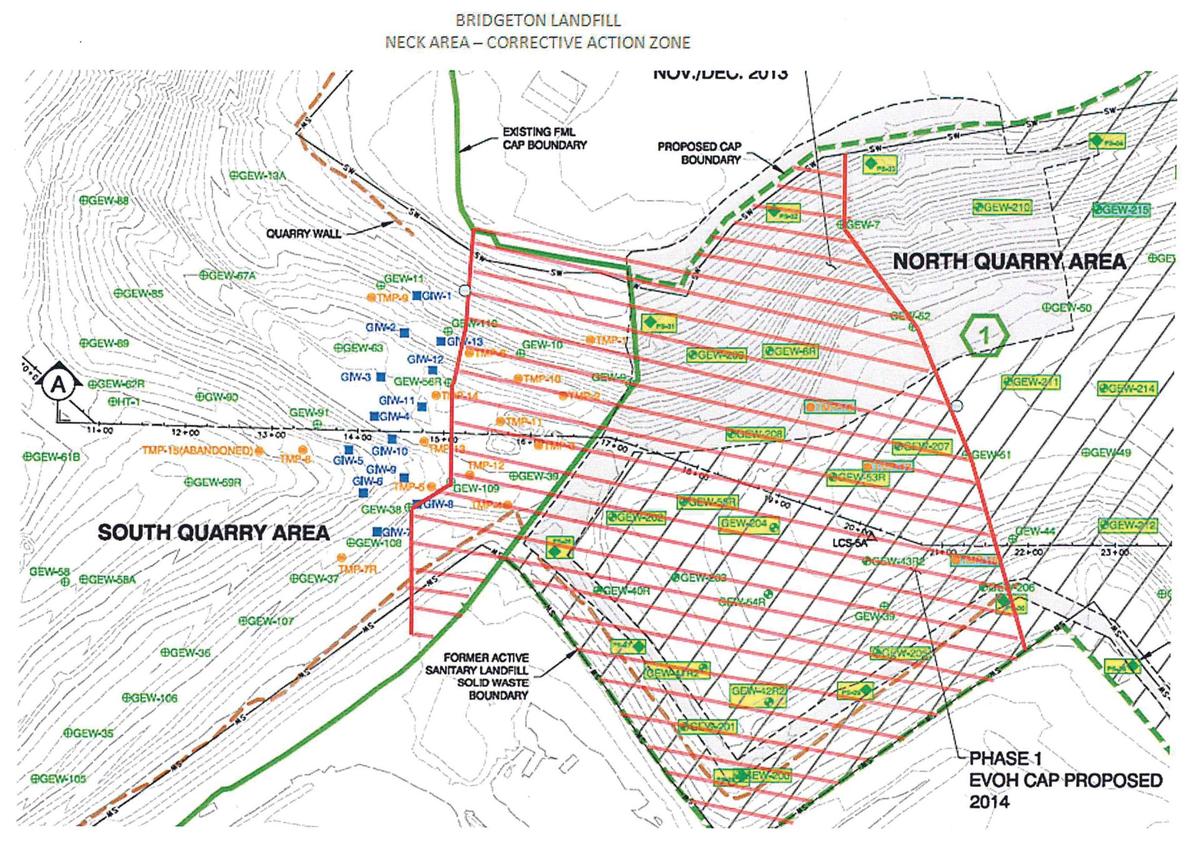St. Louis Public Radio
by VÉRONIQUE LACAPRA
Updated 10/17/14: Republic Services has confirmed that it agreed on Thursday, in writing, to comply with all of the Missouri Department of Natural Resources’ requirements ― although the company remains committed to its position that the additional measures are not needed.
Our original story:
The Missouri Department of Natural Resources says the underground fire at the Bridgeton Landfill is spreading and that the landfill’s owner, Republic Services, needs to do more to stop it.

Republic says all its data ― including subsurface temperatures, carbon monoxide levels and surface settlement ― indicate that the chemical reaction is contained and moving south, away from the radioactive waste at the adjacent West Lake Landfill.
On this map, the location of the new temperature monitoring probes that Mo. Dept. of Natural Resources wants Republic Services to install is marked with a purple line.
CREDIT MISSOURI DEPARTMENT OF NATURAL RESOURCES
This may all sound familiar, but here are the new details:
Last week, the MDNR’s Chris Nagel sent a letter to Republic Services. In it he said that recent data revealed “a continuing upward trend in temperature in the neck area of the Bridgeton Landfill,” and that Republic needs to do more temperature monitoring “to allow for continued evaluation of the northward migration of the subsurface fire and for continued monitoring of impacts to landfill infrastructure.”
That’s the first time the state agency has explicitly said the fire is moving north, toward the radioactive waste, although its contractor said so in August.
In the letter, the state agency says that given that construction of a firebreak likely won’t start for another 18 months, Republic needs to do the following:

Beginning Oct. 14, 2014, Republic must submit to the MDNR weekly temperature data from 14 gas extraction wells in the neck of the landfill;
Within 30 days, Republic must start to install a line of at least 12 new temperature monitoring probes, just north of the neck of the landfill, to compensate for the “continued failure” of four probes just south of the neck (TMP-1, TMP-2, TMP-3 and TMP-4 on the maps);
Within 30 days, Republic must submit to the MDNR a “corrective action plan,” including “a method or methods for stabilizing and maintaining temperatures within the corrective action zone at less than 185ºF for gas extraction wells and less than 200ºF for temperature monitoring probes.” The “corrective action zone” is the part shaded in red, on the map below.
A spokesperson for the MDNR, Gena Terlizza, said the agency has not received that new temperature data yet. She also declined to comment Thursday on what steps the MDNR would take if Republic refused to meet its demands. We’ll update this post if that changes.
On this map, the Mo. Dept. of Natural Resources’ “corrective action zone” is shaded in red.
CREDIT MISSOURI DEPARTMENT OF NATURAL RESOURCES
Republic Services does not seem eager to comply. In emails to St. Louis Public Radio, its lead spokesperson, Russ Knocke, said the company does not believe the MDNR’s proposal is “necessary.” “We are currently implementing a heat extraction pilot study, which is dynamic and could be expanded,” Knocke said.
Republic describes that “heat extraction pilot study” here and here. The MDNR approved the pilot study in early September, and it is currently underway in the neck of the landfill. In essence, it involves using “closed-loop heat exchange pipes” to draw heat out from under the landfill surface: cool liquid goes down into the landfill through a pipe, warm liquid comes back out to a cooling device, and so on.
Knocke admits it’s an untested technology that has never been used to try to keep an underground fire from spreading. “To my knowledge, the alternative technologies are new to [the Bridgeton Landfill] and [its] engineers,” Knocke said.
But Republic Services wants to try something similar, in lieu of building a firebreak to keep the underground fire on the south quarry of the landfill from reaching the radioactive waste in the north quarry. The company submitted its analysis of alternative firebreak plans to the U.S. Environmental Protection Agency this week.
The company’s preferred option was not building a firebreak at all. “There is no health, safety or environmental reason to build a barrier,” Knocke said.
In its analysis, the company criticized the firebreak options proposed by the U.S. Army Corps of Engineers, and instead came up with one of their own: a “heat extraction barrier” (option 4). It would involve the gas extraction wells and heat exchange pipes Republic is trying out in the landfill’s neck, but they would run in two lines “along the northern boundary of the North Quarry.” You can find detailed maps of the proposal, here. But be forewarned: the images are very large, and may cause your computer to freeze up (mine did).
According to Knocke, “the public debate about a barrier hypothesizes that heat from the subsurface reaction could reach RIM, or that a second reaction could originate near RIM.” RIM is “radiologically impacted material,” in other words, the radioactive waste.
CREDIT SARAH SKIOLD-HANLIN | ST. LOUIS PUBLIC RADIO
Knocke said ultimately, though, the decision about whether or not to build an “isolation barrier” will be the EPA’s. “If the EPA elects to proceed with a barrier, whatever option the Agency selects should be technically feasible, bring resolution to the matter within a reasonably fast time frame, and satisfy Lambert Airport and FAA concerns,” Knocke said.
In a written statement, the EPA said it had just begun to review Republic Services’ report and had provided copies to the Missouri Attorney General, the U.S. Army Corps of Engineers and the St. Louis Airport Authority for their evaluation.
Knocke said even if the underground reaction were to reach that waste, the only “adverse effect” would be increased emissions of radon gas, which Knocke said would be controlled below EPA health limits. “And, radon quickly and naturally dissipates in air,” Knocke said.
An earlier analysis by EPA scientists talks about radon gas but mentions other risks as well, including the possibility of an explosion.
Ed Smith of the Missouri Coalition for the Environment called Republic’s assertion that there would be no risk to the public if the fire reaches the radioactive waste “rather absurd.”
Smith said Republic is legally obligated to build a firebreak under its agreement with the Missouri Attorney General’s office. “What we’re seeing here is Republic Services again dictating what happens because of its unfortunate influence over this process,” Smith said.
Smith said the Missouri Department of Natural Resources’ most recent demands make sense. “We want to see that Republic Services does exactly what the DNR is requesting, instead of the DNR having to go back to court, as it’s had to do before, to get the information that it wants at this landfill,” Smith said.
The EPA appears to agree. “The additional temperature data and corrective action assessment recently required by the MDNR will support both their efforts to monitor the [subsurface smoldering event], as well as EPA and USACE efforts to evaluate barrier alternatives,” the EPA said in a statement.
But Smith said ultimately, there needs to be a broader discussion about what to do about the radioactive waste in the West Lake Landfill ― one that gives the community a real seat at the table.
And he said the only way to guarantee that the fire won’t reach the radioactive waste is for the EPA to remove it.
